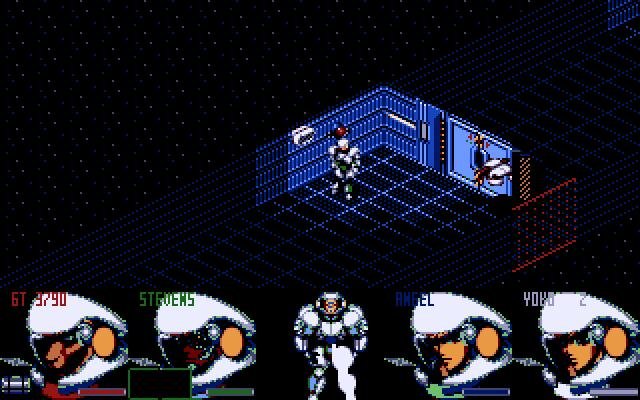Imagine an Aliens-by-way-of-Gauntlet fever dream rendered in three-quarter isometric pixels and piped into your DOS tower in 1993 by a British studio named for a leather-jacket sub-label. That’s Shadoworlds: four power-suited explorers trudging through a derelict weapons complex where every corridor hums, every door stammers, and every ammo crate feels like your final lifeline. Bizarre or classic? Absolutely both. Fundamental? If you trace the gene line that runs from Syndicate to X-COM: Apocalypse, you find Shadoworlds skulking in the air ducts whispering, “Don’t forget to micromanage oxygen.” Negligible? Only if you’re happy to let a strand of Brit-microcomputer design fade into, well, shadow. Under-rated? It reviewed solidly, then vanished beneath the shooter tsunami of ’94, so yes. Over-rated? Tell that to my teenage wrist, still tender from slamming left-mouse to swivel sensor cones. (Rhetorical question: who equips a flashlight with a limited charge in a survival scenario? Self-answer: Teque London, because terror loves logistics.)

Historical Context
Teque London, an offshoot of Krisalis Software, spent the late ’80s porting arcade hits to Amiga and Atari ST. In 1992 the team pitched an original IP: a top-down, torch-lit crawl inspired by Ridley Scott’s Alien and Games Workshop’s Space Hulk. Krisalis nodded, envisioning simultaneous Amiga, ST, and PC releases. Sixteen-bit versions shipped that autumn; a VGA-flavoured DOS port followed in early 1993 on three high-density floppies (or two 5¼″ for hold-outs), boasting Sound Blaster support and sharper enemy AI.
The timing was tricky. Doom lurked on the horizon, Ultima Underworld had just proved first-person dungeons viable, and Bullfrog’s Syndicate was about to redefine isometric carnage. Shadoworlds carved a niche instead: less bombast, more heartbeat-in-your-ears atmosphere. Amiga Power gave the original 79 percent; PC Format settled at 76 percent, praising ambience while grumbling about iron-fist difficulty. My initiation came via a shareware disk traded at XP Arcade (the pizza joint that doubled as a LAN cave). We loaded the demo on a 386SX, dimmed the lights, and learned that door locks and oxygen leaks were deadlier than any pixel xenomorph.
Mechanics
Squad, Sensors, and the Sacred Charger Panel (our absurd leitmotif)
You command four marines known only by role tags: Leader, Medic, Tech, Heavy. Each bears an arm-mounted torch that gobbles energy. Top-up comes not from loose batteries but from wall-mounted charger panels, glowing utility boxes we’ll exalt here as the Sacred Charger Panels because more than one rookie squad bled out while sprinting for their reassuring green glow. Misjudge the run between chargers and the complex fades into cobalt gloom punctuated only by motion-sensor bleeps.
Interface real estate divides into isometric window, portrait vitals, inventory grids and a sonar mini-map. Right-click a marine to cycle stances, run burns stamina, crouch shrinks profile, overwatch glues boots but auto-fires down a 45-degree cone. Split the team, stack them, form conga lines; just remember path-finding respects collision but not personal space, so the Heavy’s plasma cannon can block a Medic like a linebacker in zero-G.
Environmental Hostility, Cold, Gas and Auto-Turrets
Teque’s level architects weaponised HVAC. Cryo labs plunge temperatures; linger and vitals tick from green to icy blue while movement slows as if trudging syrup. Heat zones roast armour. Vent shafts spit halogen gas, spiking heart-rate monitors. Automated turrets pivot on line-of-sight; Tech can hack them, but only after solving a timer-bound hex mini-puzzle reminiscent of System Shock’s later wire-hacks. The maze demands resource triage: do you spend shield cells tanking turret fire or detour for a Charger Panel to keep torches lit?
Fire-Fights and Ammo Economics
Combat unspools in real time. Plasma blasts ricochet, laser slugs perforate, EMP grenades short-circuit biomechs. Ammunition is finite, and reloads stall precious seconds. Smart players kill lights, lure aliens past chokepoints and trigger proximity mines, an embryonic form of stealth-horror tactics years before Thief mainstreamed the idea. Each victory feels manual because it is: no auto-target, no pause button, only cursor finesse and squad spacing.
Save/Load and 1993 Brutality
Saving is permitted only between missions. Let the Tech bleed out in Stage 2? You’ll hack no doors in Stage 5. Forget to visit a Charger Panel? Enjoy stumbling blind. Frustrating, yes, but that permanence breeds narrative: every casualty etches a cautionary tale you can still recite decades later.
Legacy and Influence
Commercial noise notwithstanding, Shadoworlds quietly influenced peers. Bullfrog dev diaries mention studying its cone-based LOS before polishing Syndicate. Team17’s Alien Breed: Tower Assault lifted flashlight limits. Looking Glass prototypes for Shock 1 referenced Teque’s temperature mechanic (ultimately scrapped). And when Digital Extremes built Warframe’s early corridor AI, designer Steve Sinclair tweeted kudos to “old squad-light classics,” linking a screenshot of, yes, Shadoworlds. Plans for a sequel surfaced inside Krisalis but died amid a strategic pivot toward sports licenses; only line items labelled “Shadoworlds II” remain in archived schedules.
Modern rediscovery came via Ziggurat Interactive’s 2021 re-release, bundling DOSBox and unofficial bug-fix INIs that patch a crash when dual-wielding shield cells. Speedrunners exploit overflow bugs to trick turret I-D arrays and blitz the full campaign in under 40 minutes. Twitch chat usually spends that time counting how many Charger Panels the runner dares skip.
Closing Paragraph + Score
Boot Shadoworlds today and the pixel shadows still breathe dread. Torches flicker, sonar pings crawl across the HUD, and your hand hovers above N, ready to jerk a marine into crouch the moment yellow triangles converge. No modern sheen can copy the vibe: maps small enough to memorize yet dense enough to surprise, difficulty that punishes hubris but rewards incremental mastery, and those indispensable Charger Panels whose sickly glow feels like holy writ. Sure, the UI occasionally misreads double-clicks, and the absence of mid-mission saves will bruise the impatient. But give its rhythms a night and you’ll dream in isometric blue, flashlight arcs sweeping hallways lined with unknowable machinery.
Score? 8.2 / 10. Time-capsule clunkiness aside, Shadoworlds remains a masterclass in atmospheric, systems-driven tension, proof that two megabytes of art and three floppies of code can conjure dread modern gigabyte epics still chase.